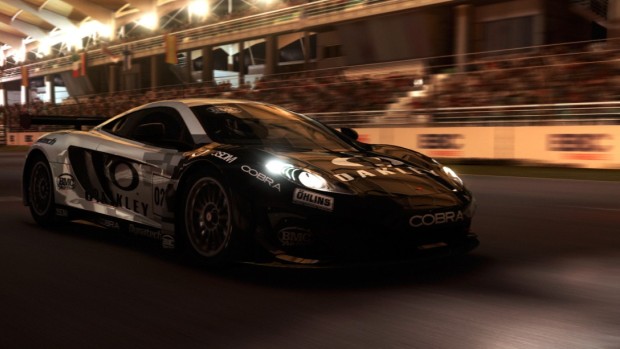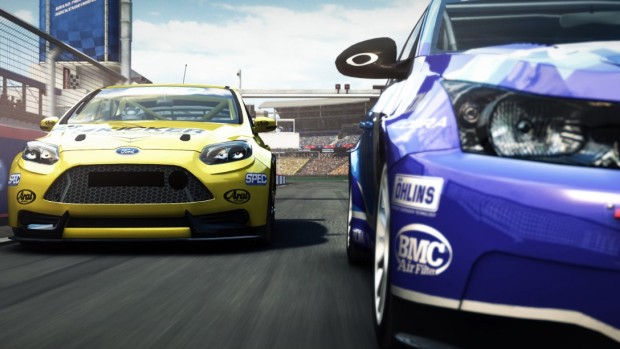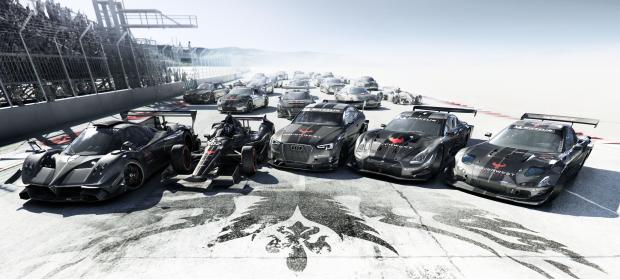Cars are scary. They’re these big, hulking metal machines that go fast with people sitting inside them. They’re designed to speed up and slow down quickly. They are easily affected by road conditions, demanding owners to be very wary of their capabilities. And, to be honest, they always look kinda grumpy.
Why is it, then, that most driving games are fairly, well, not scary? Forza and Gran Turismo are practically electronic car tourism, focusing on smooth cruises around scenic locales. Outrun, Ridge Racer and the like are arcade silliness, relishing in the act of throwing cars around impossible turns without consideration for the brake. Even the games that are interested in the crashing, the Burnouts, Flatouts and Destruction Derbys, feel more like slapstick car comedy than a simulation of metal crunching on metal. But GRID Autosport? GRID Autosport is terrifying.

This is a game that understands what you’re doing – you’re driving a big metal machine – and every facet of its design feeds into asserting this fact. Whether you’re working your way around traditional tracks in a Touring car, Open Wheeler or a nighttime Endurance race, practising techniques in the Tuner events or struggling through the tight bends of a Street circuit (these are the five unique disciplines that define GRID Autosport), GRID Autosport is committed to making your car feel like a big chunky monster.
It’s a masterstoke of superlative presentation. Take Forza 5 for example: that title may have laser scanned its tracks for absolute perfection in their recreation, but its driving still lacks the violent soul that fuels GRID Autosport. Driving around a track in Forza 5 feels like a smooth jaunt; driving around a track in GRID Autosport feels like an endeavour.
The camera has a lot to answer for, juddering as you accelerate and seemingly reacting to every shift in steering, but the sound design is king. Played in cockpit cam (as it should be – this feature’s exclusion from GRID 2 was a shocking omission) the sound is appropriately muffled. Take a hit and the thundering whump will strike you to your core, but these bass heavy paint trades are only the start.

One time while driving I picked up on a distinctly “off” sound. I remember thinking, “that grating effect wasn’t there before” (I was on a straight, and my drive shaft was already knackered from a painful Ford sandwich around the first bend, so I didn’t feel any worse). I tapped the d-pad to see what my instructor had to say, which was this: “Your front left wheel has blown”. Yeah, that grating was metal on tarmac…
And that’s before your windows shatter. Should this happen (hey, Street races in GRID Autosport are violent, yeah? We’re not all perfect drivers), the sound of the outside will hit you like a tsunami. Where before you could concentrate, now the petrol fumes and crowd jeers consume your ears. Playing GRID Autosport in cockpit cam is truly a wonderful thing (and it will be more wonderful with the non-blurry texture patch that’s been promised).
This is ultimately GRID Autosport’s biggest success. Well, the principle of this is its biggest success. GRID Autosport is a reaffirmation of everything that made GRID grand, and more-so. I could moan about load times being a bit long, I could labour the point that solo progression is a bit rote (play races in the five previously mentioned disciplines to gain XP to unlock more races, rinse and repeat), but to focus on those things would be to ignore the success that is the aggressive, rewarding driving at GRID Autosport’s heart.
And when I say it’s the game’s principle that is its success, I mean what the game stands for. GRID 2 was an entertaining game, but it was a bit of a betrayal of what made GRID so good. The cocky, modern presentation grated next to a limited feature set and curiously absent hallmarks of the name. GRID Autosport forgoes attempts to appease marketing trends and focuses on its five disciplines with commendable aptitude. Each style of racing is unique, and each feels nicely developed and, alongside GRID Autosport’s well-developed damage engine, the narrative of each race is intoxicatingly spontaneous and reactive, an element notably lacking from more po-faced sim racers like Forza and Gran Turismo.
Now, that’s not me saying that GRID Autosport is hands down better than those titles, just that it’s different. If you’re a car voyeur, someone who likes to eyeball the leather and feel the torque, the platform’s leading car games will still consume your attention. GRID Autosport is less about what you’re driving, and more about the thrill of the now: learning the bends of a track, how to temper your acceleration to deal with Dubai’s slippery dock portion, coping with a change in performance after a misguided overtake attempt. That’s not to say that the range of cars isn’t wide and interesting – it is – just that Autosport is more of a brawl, and less of a cruise.
VERDICT: Five styles of driving all done justice with one of the most violent and emergent racing engines available make GRID Autosport a compelling title for both car enthusiasts and petrol heads alike. Even if your interest in cars is merely fleeting, GRID Autosport juggles realism and aggressive satisfaction to deliver an intoxicating mix somewhere between the joy of an arcade racer and the science of a true sim. Excellent.

VERY GOOD. An 8/10 is only awarded to a game we consider truly worthy of your hard-earned cash. This game is only held back by a smattering of minor or middling issues and comes highly recommended.
Review code provided by publisher.





